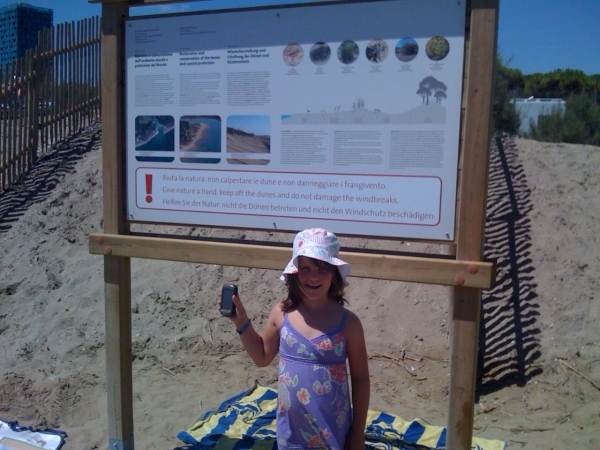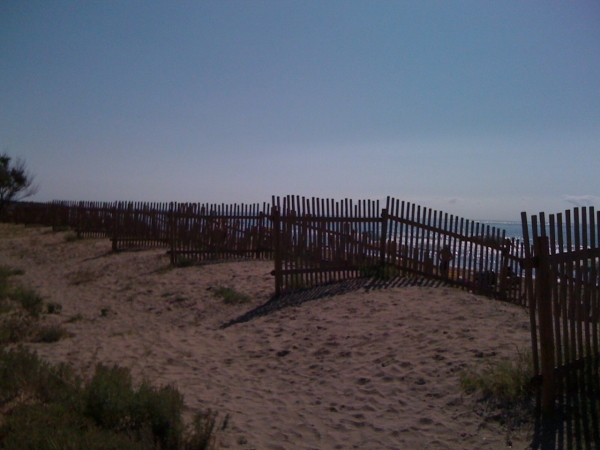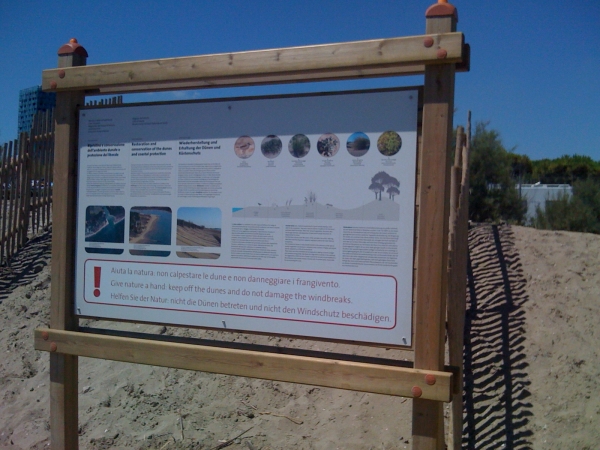ITALIANO - Dune Costieri de Jesolo
Le dune si formano sulle coste dove la combinazione dei venti e
l'apporto di sedimenti da parte delle correnti permettono
l'accumulo di sabbia sulla spiaggia.
La parte superiore della spiaggia, una volta asciutta, può
perdere parte della sabbia a causa dell'azione del vento,
specialmente se la sabbia è molto fine e la formazione delle dune
procede nella direzione predominante dove spira il vento. Nel
processo di formazione delle dune le piante pioniere svolgono un
ruolo fondamentale, consentendo la fissazione e la stabilizzazione
della sabbia che altrimenti verrebbe dispersa altrove.
Le dune forniscono alla spiaggia luoghi al riparo dal vento e
dal sole.
Le dune che si trovano in prossimità del fiume Piave sulla costa
di Jesolo-Cortellazzo hanno, da molti anni, perso la loro
efficienza (io direi funzione …) a causa del vento di
scirocco e delle inondazioni avute nelle stagioni invernali.
A causa di questo e per contrastare il fenomeno
dell’erosione il governo italiano ha costruito una linea di
difesa nel mare (barriere) che sono diventati rifugi/tane di molti
animali.
Per fare una lista di questi nascondigli/tane effettivamente
esistenti, aiutati con le coordinate riportate e marca i
ritrovamenti e le dune.
Invia le risposte alle mie domande e, molto gradita sarebbe una
foto con te vicino alle dune, anche se è da considerare
opzionale.
1 valutazione di quanto sono alte le dune
2 sotto la foto riportante il punto del del ritrovamento e delle
dune, fammi sapere a cosa si riferisce ...
ENGLISH - the Dunes of Jesolo

Dunes form where constructive waves encourage the accumulation
of sand, and where prevailing onshore winds blow this sand inland.
There need to be obstacles for example, vegetation, pebbles and so
on to trap the moving sand grains. As the sand grains get trapped
they start to accumulate, starting dune formation. The wind then
starts to affect the mound of sand by eroding sand particles from
the windward side and depositing them on the leeward side.
Gradually this action causes the dune to “migrate”
inland, as it does so it accumulates more and more sand. Dunes
provide privacy and shelter from the wind.
Ecological succession on coastal dunes
Coastal dunes in Curonian spit.As a dune forms, plant succession
occurs. The conditions on an embryo dune are harsh, with salt spray
from the sea carried on strong winds. The dune is well drained and
often dry, and composed of calcium carbonate from seashells.
Rotting seaweed, brought in by storm waves adds nutrients to allow
pioneer species to colonize the dune. These pioneer species are
marram grass, sea wort grass and other sea grasses in the United
Kingdom. These plants are well adapted to the harsh conditions of
the fore-dune typically having deep roots which reach the water
table, root nodules that produce nitrogen compounds, and protected
stoma, reducing transpiration. Also, the deep roots bind the sand
together, and the dune grows into a fore dune as more sand is blown
over the grasses. The grasses add nitrogen to the soil, meaning
other, less hardy plants can then colonize the dunes. Typically
these are heather, heaths and gorses. These too are adapted to the
low soil water content and have small, prickly leaves which reduce
transpiration. Heather adds humus to the soil and is usually
replaced by coniferous trees, which can tolerate low soil pH,
caused by the accumulation and decomposition of organic matter with
nitrate leaching. Coniferous forests and heathland are common
climax communities for sand dune systems.
Young dunes are called yellow dunes and dunes which have high
humus content are called grey dunes. Leaching occurs on the dunes,
washing humus into the slacks, and the slacks may be much more
developed than the exposed tops of the dunes. It is usually in the
slacks that more rare species are developed and there is a tendency
for the dune slacks soil to be waterlogged and where only marsh
plants can survive. These plants would include: creeping willow,
cotton grass, yellow ins, reeds, and rushes. As for the species,
there is a tendency for natterjack toads to breed here.
the Dune near the River Piave on the coast of Jesolo-Cortellazzo
has, over the last years, lost its efficiency cause of the scirocco
winds in the last winters and the flooding.
cause of that and to go against the phenomenon of the erosion
the Italian goverment built defense lines in the ocean
(waterbreaks) which are now home of different animals.
To log this cache as a found please go to the listed
coordinates, find the sign and the dunes
Send the answers to my questions and great would be a picture
with you at the dunes, but that is optional.
1 estimate how tall the dunes are
2 under the picture on the sign of the dunes, tell me what the
text is refering to

GERMAN
Die Dünenfront in der NÄhe der Mündung des Flusses Piave, an der
Küste von Jesolo, Cortellazzo hat im Laufe der letzten Jahre,
aufgrund der zurückgehenden Küste und im besonderen wegen der durch
den Scirocco-Wind im vergangenen Winter verursachten Fluten eine
Verringerung ihrer Effizienz erlitten.
Zwecks aufrechterhaltung der Küste und um diesen Phänomen der
Erosion entgegenzuwirken wurden Verteidigungsstruktunren im Meer
(Wasserbrecher) errichtet, künstliche Strandaufschüttungen,
Verstärkungen und Festigungen der Dünen realisiert die eine
wirksame Verteidigung der dahinterliegenden Wohnbereiche und einen
bedeutenden Lebensraum für die typische Flora und Fauna
darstellt
Damit die neuen Dünen im Gebiet von Cortellazzo eine grössere
Stabilität erlangen können, wurden Windbrecher errichtet. Es
handelt sich um Strukturen die die Anhäfung des Sandes begünstigen,
der von den jahrezeitbedingten Winden transportiert wird
die Anhäufungszonen oberhalb der Windbrecher wurden mit jungem
Strandhafer bepflanzt der Strandhafer ist für Dünen
charakteristisch. Eine grasartige Pflanze mit ausgeprägten Wurzeln
die den Sand festigen und die Entstehung der Küstendünden
begünstigen
Um diesen earthcache zu loggen sendet mir bitte die antworten auf
folgende fragen und optional belegt durch ein foto das ihr dort
wart.
1 schaetzt die hoehe der duenen an dieser stelle
2 was ist unter dem bild auf der hinweistafel beschrieben


Free counters